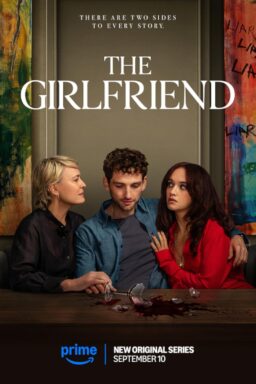“Gentlemen Prefer Blondes” was in heavy rotation at our house when my daughter’s age was still in the single digits. She enjoyed the strong friendship between the two powerful female characters (much easier to understand than the romances), the brassy color, the songs, and the comedy. Just like adult viewers! There are two “romantic” suitors we are supposed to take seriously, played by Tommy Noonan and Elliot Reid (who?) and two comic suitors, Sir Francis Beekman, a doddering millionaire played by Charles Coburn, and Henry Spofford, literally a boy: George “Foghorn” Winslow. The latter comedy actors are veterans of Hawks’ earlier film, “Monkey Business.” My daughter adored Winslow, finding him completely hilarious as a kid herself. The romantic objects of affection, bland and annoying, are completely outmatched by the stunning Lorelei and Dorothy, embodied by goddess-like Marilyn Monroe and Jane Russell.
The 1950s was a decade of great sexual repression, and the culture tugged towards the nuclear family that had been disrupted during WWII. This obsession often focused on voluptuous women’s bodies, and few were more notable than that of Russell and Monroe, the latter, in 1953, at the beginning of her star career. Yet, due to the heavily enforced Production Code, the costumes on screen could reveal no cleavage and no breast movement, which resulted in stiff, formfitting, and often high-necked gowns that look extremely uncomfortable to wear. Most of the attire is not what you would necessarily consider sexy, even if the women who wear them are.
Another fashion highlight of 1953 was “Roman Holiday,” starring Audrey Hepburn, which foregrounded a completely different beauty aesthetic. When Edith Head was assigned the costumes for the film, she assumed she would be disguising what the 1950s often considered figure flaws: Hepburn’s flat chest, long neck, and skinny arms, and was surprised that she would be asked to lean into what was considered an unconventional beauty. Hepburn’s figure is still considered a fashion ideal, her look often emulated. Although there is now a trend to celebrate more curvaceous figures, until recently, few modern women would have envied and copied the William Travilla costumes, or the generous female figures in “Gentlemen Prefer Blondes.”

Ed Sikov writes in Laughing Hysterically, “When we look back at the 1950s we see a culture of extreme neurosis and paranoia, an age that was defined by inner turmoil and external threat but that nevertheless never had the relaxing benefit of a full-fledged breakdown … The coffins, pills, drinks, songs, breasts and psychiatrists’ couches that litter films of the period were not merely pervasive; they were, often deliberately the sources of comic pleasure.” (Sikov 17–19).
The film opens with a Technicolor jolt: in front of a blue sequined curtain, Monroe and Russell in formfitting red sparkly dresses storm the stage as “Two Little Girls From Little Rock.” They state from the very opening frame that they are going to be in control. They even supersede the conventional movie titles; they don’t require any introduction other than their own.
Anita Loos wrote the novel Gentlemen Prefer Blondes in 1925. You can read it for free online: https://www.gutenberg.org/ebooks/66829. It’s written as a diary by Lorelei, one of whose gentlemen friends wishes to “educate” her, and it is still hilarious:
“So Lady Shelton was really delighted to have we Americans come to her house. I mean she took Dorothy and I into the back parlor and tried to sell us some shell flowers she seems to make out of sea shells for 25 pounds. So we asked her how much it was in money and it seems it is 125 dollars. I mean I am really going to have quite a hard time in London with Dorothy because she really should not say to an English lady what she said. I mean she should not say to an English lady that in America we use shells the same way only we put a dry pea under one of them and call it a game. But I told Lady Shelton we really did not need any shell flowers. So Lady Shelton said she knew we Americans loved dogs so she would love for us to meet her mother” (Loos 67).

Actress and Hollywood chronicler Louise Brooks loved the book, writing “I think Gentlemen Prefer Blondes is a work of art, as good in its way as Jane Austen’s Pride and Prejudice.” It became a culture-defining work of the Jazz Age, and was adapted as a play in 1926. Transformed into a Broadway musical in 1949, it made a star of its Lorelei, Carol Channing. According to Wikipedia, the musical adds and subtracts characters from the book, retaining the transatlantic crossing, Sir Francis Beekman, Henry Spofford, and the tiara, all of which we encounter in the movie version, but little else.
Director Howard Hawks had never done a musical, but he owed Fox one more picture, and he was game. The show had already been running on Broadway for two years when Fox paid $150,000 for the rights, intending to star their leading box office blonde, Betty Grable, with Ginger Rogers as Dorothy. But Grable’s price was too high, and they decided to take a chance on Monroe, partly because she was still cheap in the salary department. She only made $18,000 for “Gentlemen Prefer Blondes.” In contrast, Jane Russell, still under personal contract to Howard Hughes, made $200,000.
In the play and Broadway musical, Dorothy was a supporting part, and the role was built up so that Russell (the bigger star) and Monroe would be more equal. The transformation makes it an enjoyable look at female friendship, never a common topic in classic film. The 1920s setting was moved to the present day 1950s, and virtually all the prior material of book and play was discarded. The book is essentially a grand tour of Europe with Lorelei and Dorothy lunching, shopping, and nightclubbing with a parade of gentleman friends. And there is an adult Henry Spofford (rather than the child played by George Winslow) who they meet on “the orient express in the Central of Europe.” In the book, Lorelei is briefly engaged to him. “I mean it is unusual to see a gentleman who is such a young gentleman as Mr. Spoffard be so Prespyterian [sic], because when most gentlemen are 35 years of age their minds nearly always seem to be on something else” (Loos 136). There are two new songs especially written for the film: “Anyone Here for Love?” and “When Love Goes Wrong.”

Although the press tried to manufacture a feud between the two stars, Russell, a down-to-earth and unpretentious person, welcomed Monroe and warmly befriended her. She stuck close to her during rehearsals for reassurance and counseled her on managing a relationship with a professional athlete; Monroe was dating Joe DiMaggio, and Russell was married to the LA Rams quarterback Bob Waterfield. Jane acted as a go-between when Hawks and Monroe failed to communicate, which was fairly often. Hawks was annoyed by Monroe’s reliance on her drama coach, a quirk that would drive her directors to distraction. Russell felt the part of Dorothy was much like the way she was in real life, and enjoyed the opportunity to play a more natural role.
With the new songs, about 40 percent of the finished film consisted of musical numbers. Hawks had no background in musical comedy, so to stage the songs, Jack Cole was hired, and he is essentially responsible for the most memorable sequences in the film. His previous major star experience was with Rita Hayworth in “Cover Girl” and “Gilda.” He became a kind of mentor for Monroe for the remainder of her musical career. Hawks was not even on the set when the musical numbers were being filmed, just Cole and his assistant, Gwen Verdon. He worked the two actresses hard but made them look like much better dancers than they were. Monroe often stayed late to go over her routines.
“Anyone Here for Love?” is probably the most homoerotic musical number ever filmed, with its parade of shirtless “Olympians” in naked-looking beige shorts ignoring Dorothy’s pleas for attention. There was a different song in the 1949 musical with Olympians. I can’t imagine it looked like this. As much as Lorelei and Dorothy’s bodies are on display, so are the flexing athletes, similarly unavailable to anyone but themselves. At the end of the number, one of the dancers accidentally dunks Russell into the pool. The scene was reshot, but the original take was eventually used to comic effect. Because it was sooooo gay, this number would sometimes be cut for early television airings.
This song mirrors the exquisite “Diamonds are a Girl’s Best Friend” which also features inaccessible dancers, here women who are disturbingly arrayed as chandeliers. But Monroe, in a beautifully sensual pink satin dress, again takes complete charge of her image. She sings all her own songs in the film, with the exception of the “No, definitely no” intro to “Diamonds.” I never get tired of watching this number. The whole “we’re showgirls” aesthetic the film accentuates centers around the power the women have to display and control their bodies from the stage, not only leaving the men behind romantically, but sometimes in a completely different frame. Lorelei’s beau watches her from the audience, never sharing the image with her during the “Little Rock” number, mirroring the way we in the movie audience watch Lorelei and Dorothy without ever becoming a part of the action.
Hawks enjoyed shooting the film: “You got color that really came out and hit you. There was no sense in trying to dodge it. The girls were unreal, the story was unreal, the sets, the whole premise of the thing was unreal. We were working with complete fantasy.” His enjoyment of the process helped to make Monroe, in spite of her many challenging idiosyncrasies, into a memorable star.
Laughing Hysterically: American Screen Comedy of the 1950s by Ed Sikov, Howard Hawks: The Grey Fox of Hollywood by Todd McCarthy, Jane Russell: Mean, Moody, Magnificent by Christina Rice, Gentlemen Prefer Blondes by Anita Loos.











